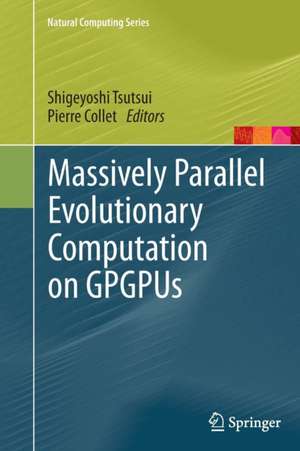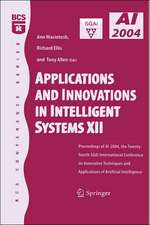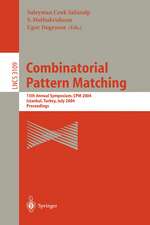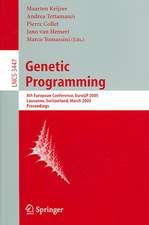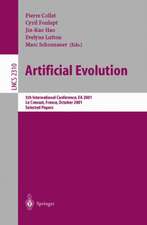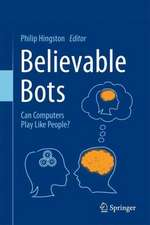Massively Parallel Evolutionary Computation on GPGPUs: Natural Computing Series
Editat de Shigeyoshi Tsutsui, Pierre Colleten Limba Engleză Paperback – 23 aug 2016
The three chapters of Part I are tutorials, representing a comprehensive introduction to the approach, explaining the characteristics of the hardware used, and presenting a representative project to develop a platform for automatic parallelization of evolutionary computing (EC) on GPGPUs. The 10 chapters in Part II focus on how to consider key EC approaches in the light of this advanced computational technique, in particular addressing generic local search, tabu search, genetic algorithms, differential evolution, swarm optimization, ant colony optimization, systolic genetic search, genetic programming, and multiobjective optimization. The 6 chapters in Part III present successful results from real-world problems in data mining, bioinformatics, drug discovery, crystallography, artificial chemistries, and sudoku.
Although the parallelism of EAs is suited to the single-instruction multiple-data (SIMD)-based GPU, there are many issues to be resolved in design and implementation, and a key feature of the contributions is the practical engineering advice offered. This book will be of value to researchers, practitioners,and graduate students in the areas of evolutionary computation and scientific computing.
| Toate formatele și edițiile | Preț | Express |
|---|---|---|
| Paperback (1) | 340.82 lei 6-8 săpt. | |
| Springer Berlin, Heidelberg – 23 aug 2016 | 340.82 lei 6-8 săpt. | |
| Hardback (1) | 340.42 lei 38-44 zile | |
| Springer Berlin, Heidelberg – 19 dec 2013 | 340.42 lei 38-44 zile |
Din seria Natural Computing Series
- 20%
 Preț: 507.37 lei
Preț: 507.37 lei - 20%
 Preț: 305.90 lei
Preț: 305.90 lei - 20%
 Preț: 992.26 lei
Preț: 992.26 lei - 20%
 Preț: 617.13 lei
Preț: 617.13 lei - 20%
 Preț: 645.47 lei
Preț: 645.47 lei - 20%
 Preț: 642.65 lei
Preț: 642.65 lei - 20%
 Preț: 998.04 lei
Preț: 998.04 lei - 18%
 Preț: 963.60 lei
Preț: 963.60 lei - 20%
 Preț: 655.20 lei
Preț: 655.20 lei - 20%
 Preț: 615.69 lei
Preț: 615.69 lei - 20%
 Preț: 645.65 lei
Preț: 645.65 lei - 20%
 Preț: 640.19 lei
Preț: 640.19 lei - 20%
 Preț: 655.02 lei
Preț: 655.02 lei -
 Preț: 384.70 lei
Preț: 384.70 lei - 20%
 Preț: 652.54 lei
Preț: 652.54 lei - 20%
 Preț: 649.28 lei
Preț: 649.28 lei - 20%
 Preț: 330.75 lei
Preț: 330.75 lei - 20%
 Preț: 328.09 lei
Preț: 328.09 lei -
 Preț: 389.70 lei
Preț: 389.70 lei - 20%
 Preț: 644.66 lei
Preț: 644.66 lei - 20%
 Preț: 333.88 lei
Preț: 333.88 lei - 20%
 Preț: 1299.31 lei
Preț: 1299.31 lei - 20%
 Preț: 528.47 lei
Preț: 528.47 lei - 20%
 Preț: 648.11 lei
Preț: 648.11 lei - 15%
 Preț: 639.90 lei
Preț: 639.90 lei - 20%
 Preț: 322.43 lei
Preț: 322.43 lei - 20%
 Preț: 657.83 lei
Preț: 657.83 lei - 20%
 Preț: 659.31 lei
Preț: 659.31 lei - 20%
 Preț: 997.56 lei
Preț: 997.56 lei - 20%
 Preț: 508.61 lei
Preț: 508.61 lei -
 Preț: 400.85 lei
Preț: 400.85 lei - 20%
 Preț: 653.38 lei
Preț: 653.38 lei - 20%
 Preț: 308.60 lei
Preț: 308.60 lei - 20%
 Preț: 654.05 lei
Preț: 654.05 lei - 15%
 Preț: 652.17 lei
Preț: 652.17 lei - 20%
 Preț: 336.54 lei
Preț: 336.54 lei - 20%
 Preț: 656.19 lei
Preț: 656.19 lei
Preț: 340.82 lei
Preț vechi: 426.03 lei
-20% Nou
Puncte Express: 511
Preț estimativ în valută:
65.22€ • 68.23$ • 54.18£
65.22€ • 68.23$ • 54.18£
Carte tipărită la comandă
Livrare economică 02-16 aprilie
Preluare comenzi: 021 569.72.76
Specificații
ISBN-13: 9783662513453
ISBN-10: 3662513455
Pagini: 465
Ilustrații: XII, 453 p. 199 illus., 95 illus. in color.
Dimensiuni: 155 x 235 x 24 mm
Greutate: 0.65 kg
Ediția:Softcover reprint of the original 1st ed. 2013
Editura: Springer Berlin, Heidelberg
Colecția Springer
Seria Natural Computing Series
Locul publicării:Berlin, Heidelberg, Germany
ISBN-10: 3662513455
Pagini: 465
Ilustrații: XII, 453 p. 199 illus., 95 illus. in color.
Dimensiuni: 155 x 235 x 24 mm
Greutate: 0.65 kg
Ediția:Softcover reprint of the original 1st ed. 2013
Editura: Springer Berlin, Heidelberg
Colecția Springer
Seria Natural Computing Series
Locul publicării:Berlin, Heidelberg, Germany
Cuprins
Chap. 1 Why GPGPUs for Evolutionary Computation?.- Chap. 2 Understanding NVIDIA GPGPU Hardware.- Chap. 3 Automatic Parallelization of EC on GPGPUs and Clusters of GPGPU Machines with EASEA and EASEA-CLOUD.- Chap. 4 Generic Local Search (Memetic) Algorithm on a Single GPGPU Chip.- Chap. 5 arGA: Adaptive Resolution Micro-genetic Algorithm with Tabu Search to Solve MINLP Problems Using GPU.- Chap. 6 An Analytical Study of GPU Computation by Parallel GA with Independent Runs.- Chap. 7 Many-Threaded Differential Evolution on the GPU.- Chap. 8 Scheduling Using Multiple Swarm Particle Optimization with Memetic Features on Graphics Processing Units.- Chap. 9 ACO with Tabu Search on GPUs for Fast Solution of the QAP.- Chap. 10 New Ideas in Parallel Metaheuristics on GPU: Systolic Genetic Search.- Chap. 11 Genetic Programming on GPGPU Cards Using EASEA.- Chap. 12 Cartesian Genetic Programming on the GPU.- Chap. 13 Implementation Techniques for Massively Parallel Multi-objective Optimization.- Chap. 14 Data Mining Using Parallel Multi-objective Evolutionary Algorithms on Graphics Processing Units.- Chap. 15 Large-Scale Bioinformatics Data Mining with Parallel Genetic Programming on Graphics Processing Units.- Chap. 16 GPU-Accelerated High-Accuracy Molecular Docking Using Guided Differential Evolution.- Chap. 17 Using Large-Scale Parallel Systems for Complex Crystallographic Problems in Materials Science.- Chap. 18 Artificial Chemistries on GPU.- Chap. 19 Acceleration of Genetic Algorithms for Sudoku Solution on Many-Core Processors.
Notă biografică
Prof. Shigeyoshi Tsutsui received his B.Eng. and M.Eng. in electrical engineering in 1967 and 1969 respectively from Osaka City University, and he received his Ph.D. in 1985 from Osaka Prefecture University. From 1969 to 1986 he worked in Hitachi's Central Research Laboratories and Systems Development Laboratories. He joined the staff of Hannan University in 1987, where he is currently a full professor. His reseach interests include computer architectures, information and business science, artificial intelligence, and evolutionary computing, in particular applying genetic algorithms to difficult, multimodal problems.
Prof. Pierre Collet received his master's degree in operating systems from Université de Paris VI in 1990, and his Ph.D. from Université Paris-Sud (Orsay) in 1997, on the topic of computer-aided surgery through virtual reality. From 2000 to 2003 he was a researcher in the Artificial Evolution and Learning team of the Center of Applied Mathematics (CMAP) of École Polytechnique. He joined the Université du Littoral Côte d'Opale in Calais in 2003 as an assistant professor, and defended his habilitation thesis in 2004. In 2007 he became a full professor in the Image Sciences, Computer Sciences and Remote Sensing Laboratory (LSIIT) in Strasbourg, where he led the Theoretical Bionformatics, Data Mining and Stochastic Optimization (BFO) team until December 2012. Since 2011, he has been the head of the Dept. of Computer Science of the Université de Strasbourg, and since 2013 he has led the Strasbourg Complex Systems Digital Campus. His research concentrates on the optimization of complex problems using evolutionary computing, nature-inspired stochastic algorithms, and complex systems, and in particular their implementation on massively parallel hardware, with applications in collaborative work, cellular automata, biomedical devices, chemistry, control, and e-learning.
Prof. Pierre Collet received his master's degree in operating systems from Université de Paris VI in 1990, and his Ph.D. from Université Paris-Sud (Orsay) in 1997, on the topic of computer-aided surgery through virtual reality. From 2000 to 2003 he was a researcher in the Artificial Evolution and Learning team of the Center of Applied Mathematics (CMAP) of École Polytechnique. He joined the Université du Littoral Côte d'Opale in Calais in 2003 as an assistant professor, and defended his habilitation thesis in 2004. In 2007 he became a full professor in the Image Sciences, Computer Sciences and Remote Sensing Laboratory (LSIIT) in Strasbourg, where he led the Theoretical Bionformatics, Data Mining and Stochastic Optimization (BFO) team until December 2012. Since 2011, he has been the head of the Dept. of Computer Science of the Université de Strasbourg, and since 2013 he has led the Strasbourg Complex Systems Digital Campus. His research concentrates on the optimization of complex problems using evolutionary computing, nature-inspired stochastic algorithms, and complex systems, and in particular their implementation on massively parallel hardware, with applications in collaborative work, cellular automata, biomedical devices, chemistry, control, and e-learning.
Textul de pe ultima copertă
Evolutionary algorithms (EAs) are metaheuristics that learn from natural collective behavior and are applied to solve optimization problems in domains such as scheduling, engineering, bioinformatics, and finance. Such applications demand acceptable solutions with high-speed execution using finite computational resources. Therefore, there have been many attempts to develop platforms for running parallel EAs using multicore machines, massively parallel cluster machines, or grid computing environments. Recent advances in general-purpose computing on graphics processing units (GPGPU) have opened up this possibility for parallel EAs, and this is the first book dedicated to this exciting development.
The three chapters of Part I are tutorials, representing a comprehensive introduction to the approach, explaining the characteristics of the hardware used, and presenting a representative project to develop a platform for automatic parallelization of evolutionary computing (EC) on GPGPUs. The ten chapters in Part II focus on how to consider key EC approaches in the light of this advanced computational technique, in particular addressing generic local search, tabu search, genetic algorithms, differential evolution, swarm optimization, ant colony optimization, systolic genetic search, genetic programming, and multiobjective optimization. The six chapters in Part III present successful results from real-world problems in data mining, bioinformatics, drug discovery, crystallography, artificial chemistries, and sudoku.
Although the parallelism of EAs is suited to the single-instruction multiple-data (SIMD)-based GPU, there are many issues to be resolved in design and implementation, and a key feature of the contributions is the practical engineering advice offered. This book will be of value to researchers, practitioners, and graduate students in the areas of evolutionary computation and scientific computing.
The three chapters of Part I are tutorials, representing a comprehensive introduction to the approach, explaining the characteristics of the hardware used, and presenting a representative project to develop a platform for automatic parallelization of evolutionary computing (EC) on GPGPUs. The ten chapters in Part II focus on how to consider key EC approaches in the light of this advanced computational technique, in particular addressing generic local search, tabu search, genetic algorithms, differential evolution, swarm optimization, ant colony optimization, systolic genetic search, genetic programming, and multiobjective optimization. The six chapters in Part III present successful results from real-world problems in data mining, bioinformatics, drug discovery, crystallography, artificial chemistries, and sudoku.
Although the parallelism of EAs is suited to the single-instruction multiple-data (SIMD)-based GPU, there are many issues to be resolved in design and implementation, and a key feature of the contributions is the practical engineering advice offered. This book will be of value to researchers, practitioners, and graduate students in the areas of evolutionary computation and scientific computing.
Caracteristici
First book dedicated to exciting new approach Content characterized by emphasis on solving practical problems Valuable for researchers, practitioners, and graduate students Includes supplementary material: sn.pub/extras
